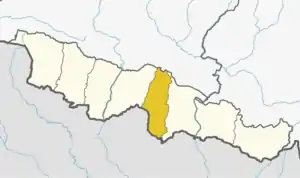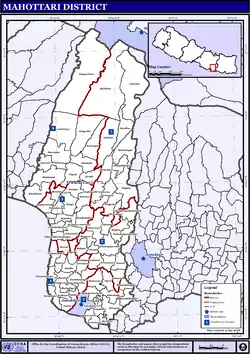Mahottari District
Mahottari District (Nepali: महोत्तरी जिल्ला,ⓘ), a part of Madhesh Province, is one of the seventy-seven districts of Nepal. The district, with Jaleshwar as its district headquarters, covers an area of 1,002 km2 (387 sq mi) and had a population of 553,481 in 2001, 627,580 in 2011 and 705,838 in 2021 census.[1] Its headquarters is located in Jaleshwar, a neighbouring town of the historical city of Janakpur. The name Jaleshwar means the 'God in Water'. One can find a famous temple of Lord Shiva in Water there. Jaleshwar lies at a few kilometres distance from the Nepal-India border and has a majority Maithili population.
Mahottari District
महोत्तरी जिल्ला | |
|---|---|
 Jaleshwar Mahadev Temple, a major Shiva temple in Mahottari | |
 Mahottari District (dark yellow), in Madhesh Province | |
| Country | |
| Region | Mithila |
| Province | Madhesh Province |
| Admin HQ. | Jaleshwar |
| Government | |
| • Type | Coordination committee |
| • Body | DCC, Mahottari |
| Area | |
| • Total | 1,002 km2 (387 sq mi) |
| Population (2021) | |
| • Total | 705,838 |
| • Density | 700/km2 (1,800/sq mi) |
| Time zone | UTC+05:45 (NPT) |
| Telephone Code | 044 |
| Main Language(s) | Maithili (88.0%), Nepali (5.6%), other (6.4%) |
| Website | ddcmahottari |
Geography and climate
| Climate Zone[2] | Elevation Range | % of Area |
|---|---|---|
| Lower Tropical | below 300 meters (1,000 ft) | 85.0% |
| Upper Tropical | 300 to 1,000 meters 1,000 to 3,300 ft. |
15.0% |
Demographics
| Census year | Pop. | ±% p.a. |
|---|---|---|
| 1981 | 361,054 | — |
| 1991 | 440,146 | +2.00% |
| 2001 | 553,481 | +2.32% |
| 2011 | 627,580 | +1.26% |
| 2021 | 715,040 | +1.31% |
| Source: Citypopulation[3] | ||
At the time of the 2011 Nepal census, Mahottari District had a population of 627,580.
As their first language, 81.0% spoke Maithili, 7.3% Urdu, 5.4% Nepali, 1.9% Magar, 1.4% Tamang, 1.1% Tharu, 0.9% Magahi, 0.2% Hindi, 0.2% Newar 0.1% Bhojpuri and 0.1% other languages.[4]
Ethnicity/caste: 15.2% were Yadav, 13.4% Musalman, 6.5% Dhanuk, 5.8% Koiri/Kushwaha, 5.1% Terai Brahmin, 4.1% Teli, 3.7% Musahar, 3.6% Chamar/Harijan/Ram, 2.5% Khatwe, 2.4% Dusadh/Paswan/Pasi, 2.4% Sudhi, 2.3% Magar, 2.2% Nuniya, 1.8% Hill Brahmin, 1.6% Baraee, 1.6% Chhetri, 1.6% Tatma/Tatwa, 1.6% Tharu, 1.5% Bin, 1.5% Kalwar, 1.5% Tamang, 1.4% Mallaha, 1.3% Hajam/Thakur, 1.3% Sonar, 1.1% Kanu, 1.1% Kewat, 1.0% Dhobi, 0.9% Kurmi, 0.9% Lohar, 0.8% Halwai, 0.7% Kami, 0.7% Newar, 0.7% Rajput, 0.6% Dhunia, 0.6% Kumhar, 0.5% Kathabaniyan, 0.4% Bantar/Sardar, 0.4% Danuwar, 0.4% Kayastha, 0.4% other Terai, 0.3% Damai/Dholi, 0.3% Mali, 0.2% Badhaee, 0.2% Dom, 0.2% Gaderi/Bhedihar, 0.2% Gharti/Bhujel, 0.2% Kumal, 0.2% Sanyasi/Dasnami, 0.1% Amat, 0.1% Majhi, 0.1% Punjabi/Sikh, 0.1% Rai, 0.1% Sarki, 0.1% Sunuwar, 0.1% Thakuri and 0.2% others.[5]
Religion: 84.2% were Hindu, 13.3% Muslim, 2.0% Buddhist, 0.1% Christian and 0.2% others.[6]
Literacy: 46.2% could read and write, 2.5% could only read and 50.9% could neither read nor write.[7]
Notable people
List ordered alphabetically
- Bhadrakali Mishra- Nepali Congress leader of Minister of Nepal at various times
- Giriraj Mani Pokharel-CPN (Maoist Centre) leader and former Minister for Education
- Hari Shankar Mishra- Current governor of Madhesh Province, former Nepali Congress leader and Member of House of Representatives
- Mahantha Thakur- Chairman of Democratic Socialist Party and former Minister for various ministries as NC leader
- Mahendra Kumar Raya- Nepali Congress leader and former Minister of state for Industry, Commerce and Supplies under Bimalendra Nidhi
- Maheshwar Prasad Singh- democracy icon and Nepali Congress leader
- Ram Narayan Mishra- Nepali Congress leader and minister in first democratically elected government of BP Koirala
- Sharat Singh Bhandari- former NC leader and senior leader of DSP, N. Also former Minister for Defence
- Shivajee Yadav-Deputy chairman of People's Progressive Party and former member of constituent assembly
Administration
The district consists of ten urban municipalities and five rural municipalities. These are as follows:[8]
- Aurahi Municipality
- Balawa Municipality
- Bardibas Municipality
- Bhangaha Municipality
- Gaushala Municipality
- Jaleshwor Municipality
- Loharpatti Municipality
- ManaraShiswa Municipality
- Matihani Municipality
- Ramgopalpur Municipality
- Ekdara Rural Municipality
- Mahottari Rural Municipality
- Pipara Rural Municipality
- Samsi Rural Municipality
- Sonama Rural Municipality
Former Village Development Committees (VDCs) and Municipalities

The 2011 National Population and Housing Census by the government of Nepal identifies 77 municipalities and village development committees (VDC) within the Mahottari District.[9]
|
|
- Household and population by districts, Central Bureau of Statistics (CBS) Nepal Archived 2013-09-27 at the Wayback Machine
- The Map of Potential Vegetation of Nepal - a forestry/agroecological/biodiversity classification system (PDF), Forest & Landscape Development and Environment Series 2-2005 and CFC-TIS Document Series No.110., 2005, ISBN 87-7903-210-9, retrieved Nov 22, 2013
- "NEPAL: Administrative Division". www.citypopulation.de.
- NepalMap Language
- NepalMap Caste
- NepalMap Religion
- NepalMap Literacy
- "स्थानिय तह". 103.69.124.141. Archived from the original on 2018-08-31. Retrieved 2018-12-06.
- National Planning Commission Secretariat (November 2012). "National Population and Housing Census 2011" (PDF). Central Bureau of Statistics. Government of Nepal. pp. 27–28. Archived from the original (PDF) on 27 September 2013. Retrieved 3 May 2015.
- "Districts of Nepal". Statoids.